Academician Chen Runsheng of the Chinese Academy of Sciences: How does artificial intelligence and big data lead to precision medicine?
Academician Chen Runsheng of the Chinese Academy of Sciences: How does artificial intelligence and big data lead to precision medicine?
November 04, 2016 Source: Lei Feng Net
Window._bd_share_config={ "common":{ "bdSnsKey":{ },"bdText":"","bdMini":"2","bdMiniList":false,"bdPic":"","bdStyle":" 0","bdSize":"16"},"share":{ }};with(document)0[(getElementsByTagName('head')[0]||body).appendChild(createElement('script')) .src='http://bdimg.share.baidu.com/static/api/js/share.js?v=89860593.js?cdnversion='+~(-new Date()/36e5)]; On November 1st, at the first China Zhigu Conference Artificial Intelligence and Industry Innovation Summit hosted by Xinhuanet and Nanjing Economic and Information Technology Committee, bioinformatics and academician Chen Runsheng of the Chinese Academy of Sciences made a speech entitled "Big Data and Speech by Precision Medicine. Academician Chen Runsheng believes that the application of technologies such as artificial intelligence and big data to the medical field will promote the development of precision medicine, and take targeted measures before the disease occurs, thus changing the concept of medical health. At the same time, artificial intelligence and big data also play a key role in studying 97% of the "dark matter information" that we do not understand in our genetic information. Overall, precision medicine is just on the road, and there are still many opportunities.
The following is the full text of the speech by Academician Chen Runsheng:
Dear experts and leaders, I am very honored to participate in this meeting. I think today I will talk about big data and precision medicine, because now everyone knows that precision medicine is very hot, although it is still younger than artificial intelligence. We know that on January 20, 2005, US President Barack Obama was conducting research on precision medicine in the United States he published. Since then, precision medicine has received universal attention in the world. In many developed countries, including our country, not only everyone. In an area that is of great concern, our national leaders have repeatedly pointed out important instructions for the development of precision medicine, and they also have concrete manifestations in funding. So today I mainly talk about four aspects of precision medicine. One is to communicate with you and I hope to start some discussions.
Â
1. Precision medicine is the combination of big data and clinical medicine
Â
The first question, what is the nature of precision medicine, what is the core? I have seen various comments in China. I have discussed various aspects of precision medicine. I think that the core of precision medicine is actually a little bit. It is very clear that it is the combination of big data and medicine. To be more specific, it is the combination of group big data and clinical medicine. In other words, the use of group big data in clinical medicine to improve the accuracy of medical diagnosis and improve the effectiveness of treatment.
This includes two meanings, one meaning big data for group learning, and the other meaning is medicine. Then the big data of the group also includes two meanings, one is omics and the other is big data. We know that in recent years, with the development of clinical research, we have obtained more and more human information at the molecular level represented by the genome. This is unprecedented before. Then, with the development of omics data represented by genomes, people are accumulating more and more information about genetic codes, not only genes, but also protein information. Later, people discovered that mining these The information will get a lot of information reflecting human health and disease in the future. Therefore, it has been suggested that if this information is applied to the clinic, it will definitely improve the clinical effect. This is the essential meaning of precision medicine. However, it is not enough to obtain only the information of these genetic codes.
Â
As we all know, all the genetic code information is very much a big data. This big data is very easy to measure, including we now know that in our country, everyone can get your inheritance by spending 10,000 yuan. Password, but you don't understand your genetic code, because there are only four words (A, C, G, T), so to understand him, you need to develop the theoretical methods and techniques of big data analysis. . Therefore, to use these omics data in large clinical practice, it must be a combination of omics data and big data analysis methods. So part of it is group big data, part is medicine, and the two combine to form the essence and core of precision medicine now. This is the first question. Regarding the essence of precision medicine, he also used the clinical data from the 1990s in the 1990s, and the development turned into translational medicine, individualized medicine. Now there is the name of precision medicine from 2011, but in any case, It is his essence that is clear, that is, the application of group big data in clinical medicine.
Â
2. Precision medicine has the potential to change the basic concepts of medical health
Â
The second question: What essential changes in precision medicine can bring to medicine. If precision medicine only increases medicine by a small percentage, I think that precision medicine will not necessarily attract more leaders' attention. As for the connotation of precision medicine, there must be some essential changes, then what is this essential change? In a word, precision medicine, in essence, has attracted the attention of leaders of all countries. It is the basic concept that precision medicine has the potential to change medical health. That is to say, the basic concept of medical treatment has been transformed from the current diagnosis and treatment to Health guarantee.
Â
We know that the current medical system is facing patients, then he mainly treats patients with so-called treatment. However, due to the development of precision medicine in the future, due to the intervention of group big data, it will make this time not only healthy. It is only for the patient, but for the whole people. If anyone measures his omniscience data and analyzes the big data of the group when he is not sick, then he can evaluate the risk factors of his future health development. Appropriate intervention, so that some diseases do not develop, some diseases reduce his degree, improve his quality of life, thus moving the entire health care system's barrier forward, and assessing and guaranteeing before the disease.
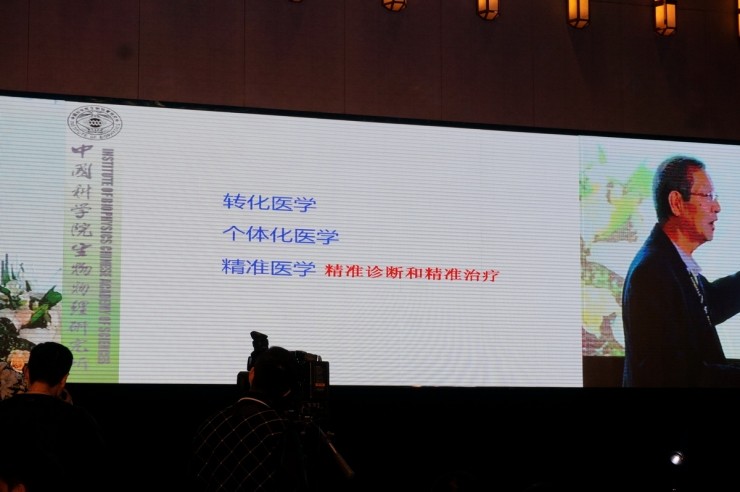
Â
(Three trends in future medicine)
Â
Such a fundamental change in concept, some people believe that it may lead to the emergence of some emerging industries, some have predicted that the new type of concept related to the so-called precision medicine will lead to a new type of transformation, perhaps by 2018, perhaps to 200 billion US dollars. It is equivalent to nearly 2 trillion yuan, which has an impact on GDP. This kind of change in the concept of nature brought about by precision medicine will certainly attract the attention of leaders of various countries. This is the second aspect, and it is estimated that some essential changes may be brought about by finishing medicine.
Â
Accurate medical research has become the commanding height of a new round of national science and technology competition and leading international strategy. Everyone knows that the United States wants to measure the genetic code of 1 million natural persons. The EU is also actively promoting research on so-called precision medicine, including Britain, France, etc. Japan is also investing in precision medicine. So how do we carefully analyze precision medicine? In what ways can he promote the transformation and development of the industry? I want to at least four aspects:
Â
The first can promote the development of massive biological sample libraries and databases. As we all know, due to the promotion of precision medicine, it is necessary to measure the group information of these people of the order of a million people. First, it involves the acquisition, storage, extraction and provision of these millions of biological samples, which is of course A big industry. At the same time, these samples have measured the data in the order of a million people and must promote the development of the corresponding large-scale database. It is estimated that the scale of this industry may be tens of billions.
Â
The second one with these samples is to measure the omics data represented by the genome, so it is necessary to measure the genome, proteome, and transcriptome. These sequencing data can reach $11.7 billion by 2018 alone. The scale. Then with the sample library and the measurement of the omics data, the next step on the basis of these massive data mining can promote the generation of a large number of new molecular diagnostic indicators. We know that there will be a lot of information related to the disease, many of which can be used as a marker for new diseases. At the same time, many new drug design targets can be found, which promotes the third industry, the related industry called molecular diagnostics and drug design targets.
Â
The fourth is of course the new medical facilities that come with the concept of precision medicine. For example, it is necessary to set up some health sources and some health workers. These are the industries that can be related to hospitals and doctors today. The industry will inevitably bring about changes, and it has already been reflected in the country. Hundreds of small companies have gradually been established. Of course, how do they come to better development is yet to be discussed.
Â
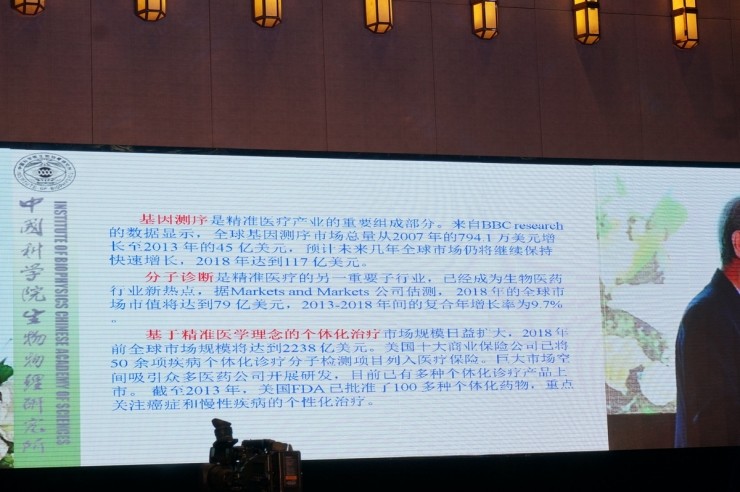
(Accurate medicine will drive the expansion of market scales such as gene sequencing, molecular diagnosis, and individualized treatment)
Â
The development goal of precision medicine in our country is not described in detail, and it is consistent with the international. In this second aspect, what essential changes can be brought about by precision medicine, how to promote the development of industry, and the development of several industries can lead or guide .
Â
3. How can I be precise?
Â
The third one I want to say is a question to achieve precision medicine. What do you want to do? What can be done to be precise? So precision medicine, I think there must be at least two conditions. The first one must have the basis of group big data. We know that precision medicine is to use group big data in clinical, so the first one you want to acquire group learning Big data, then the genomics, proteome, transfer group, metabolome, etc., these data are not useful, the second step is the mining of omics data, mining will use large The theoretical methods of data analysis, including the methods of artificial intelligence that Professor Zhang Wei just mentioned, the methods of deep learning, etc., the knowledge-based method used to mine these omics to obtain knowledge related to diseases at the molecular level, This is the first foundation.
Â
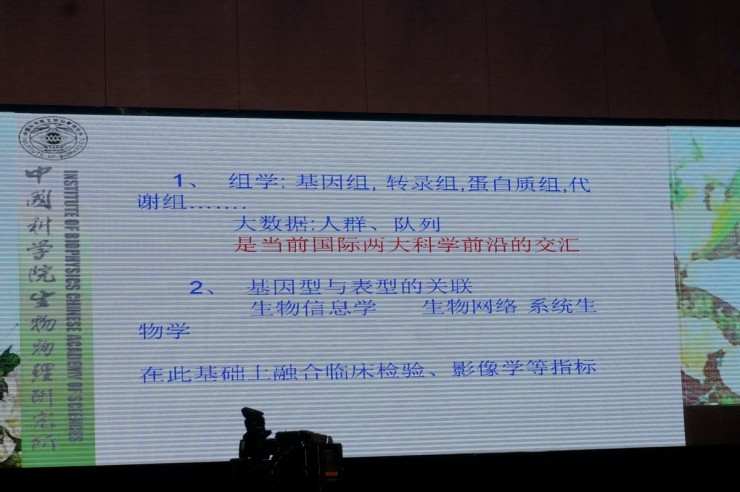
Â
(the basis of precision medicine)
Â
With these molecular knowledge and group knowledge used in clinical diseases, we must establish a second foundation, which is to build a molecular level of information nuclei represented by genotypes. Information transformation is applied to the diagnosis and treatment of diseases. Then this is to establish so-called bioinformatics, biological networks, systems biology, etc. With these two foundations, we can better achieve precision medicine, of course. A very important thing is that the development of precision medicine should be well integrated with the current clinical imaging, clinical biochemical tests, and current clinical knowledge. It is not that some companies have determined the order of their measurements. Actually, This is not the case, it should be better combined to be more accurate. Precision medicine simply applies new data to the original data to make it better.
Â
4. Precision medicine is just getting on the road
Â
At what stage is the fourth stage of precision medicine, and at what stage? As we all know, maybe our current precision medicine has become a hot word for everyone. Everyone thinks that we can do everything accurately now, and medicine is very easy to be precise. My personal point of view, although precision medicine actually may bring about changes in nature, it may lead new The development of the industry, perhaps the scale of the industry is huge, but now it is just on the road, just started! why? Under the concept of precision medicine, we still have huge challenges, and we still have great difficulties. Therefore, I will give one or two examples below to illustrate the current difficulties in finishing medicine.
Â
Why is precision medicine just on the road? Where are our opportunities for innovation, and where are we facing the challenges? I take only one example in the group study. In our clinical code, in our group studies, there is still a lot of dark information. The so-called our own genetic code is currently only able to analyze from the law. A small part, what others can't analyze is the so-called dark information in the genome. Our one's genetic code information is 3*10's nineth power. If it is bound into a book, every 3,000 characters one page, 100 pages binding layer, that is 10,000 copies. If 10,000 books are one centimeter per book, our own genetic code book is just one hundred meters. As you can imagine, your own genetic code is as high as the floor code of the forty floors, if you read all of them. You are precise. I believe that no one can be precise. What I want to tell you now is the wisdom of scientists all over the world, including the wisdom of biomedicalists. This part of the book that can be understood regularly in the world is only 3% of the genetic code. The other 97 % actually does not understand the wisdom of the world at present. So far our 97% of the genetic code is dark, I want to give you some expanded explanations below.
Â
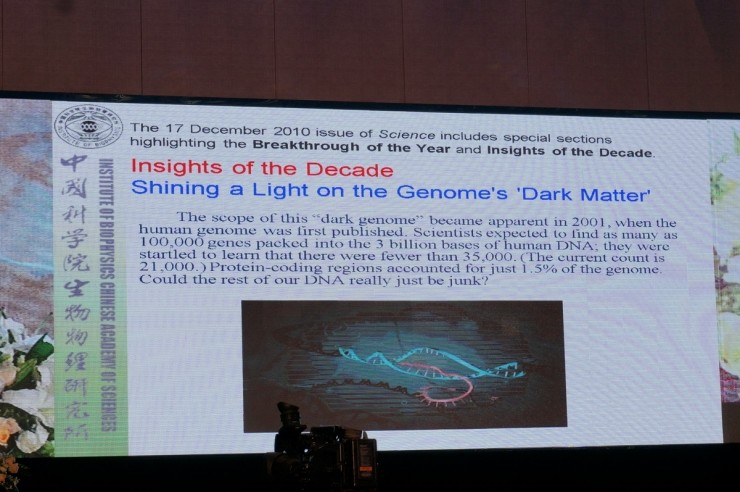
Â
(2010 Science Magazine's "Outstanding Discovery of the New Century 10 Years": Gene Dark Matter)
Â
First of all, from the perspective of genetic code, in fact, our 97% of the genetic code, from the overall, from the law, we humans still do not understand, that 3% we know from the middle school everyone knows, respect from the center development The protein information, that 3% is the genetic code of the protein, we know his classification, and also know his information, but the other 97% of the genetic code is not related to the production of the protein group, this information, so far we I don't know what he is doing. This is the so-called dark matter in the genetic code. It is also the non-coding sequence in the genetic code. Then we can think about it, when we measure the genetic code, and 97% of the passwords don't know. How do we do it accurately? So it is a lot far from precision.
Â
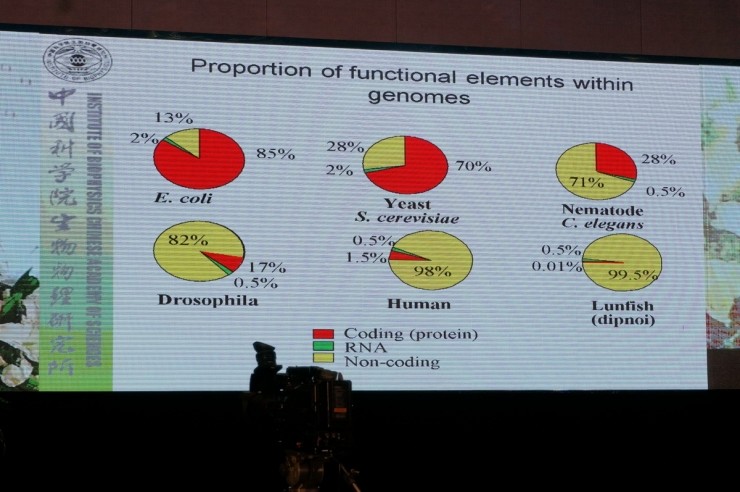
Â
(degree of decoding of different biological genes)
Â
In the 21st century, scientists raised questions about these 97% of the dark matter genetic code that we don't know yet. Is there a transcript, and is there information? In other words, is he active and exercising functions? This result is 100% positive. These non-coding sequences are the same as those of the proteins we make, and they are expressed every moment, every moment, so they are really doing biological functions. Something I can give is a few examples of his relationship with tumors. Of course, although we don't fully understand it, there are already some fragmented examples of his biological functions. For example, there is a product from 97%, called PCGEM1, which can cause prostate cancer, not caused by protein. There is also MALAT-1, which can lead to non-small cell lung cancer. We all know that our country's lung cancer is growing. In our current clinical hospitals, the indicators for detecting tumors are 3% of what I said, and the target of treatment is you. The drug used is also 3%, I tell you now, that 97%, there are many examples that he is also related to cancer, but it has never been included in our clinical diagnosis and treatment, you think this tumor can be cured Ok? You didn't think about him. Of course, you didn't think about testing and treating him. That is to say, we still have a 97% of the disease-related things that have not been so integrated into our diagnosis and treatment. This is the so-called precision medicine. The huge challenge of dark information.
Â

Â
(Relationship between long-chain non-coding MALAT-1 RNA and lung cancer)
Â
We know that 97% of the information on genetic dark matter is related to our disease and our health. How many of our codes have we found? We have about 25,000 genes, and 97% of us can evaluate now. How many originals does he have? Because of ethical reasons, we don’t know about humans. The Institute of Genetics has done research on mice and brought all the originals. Whether you are coding or non-coding, a total of 181,000 were found. This is in mice. The lower limit of the original function that actually performs the function will actually be larger than him. It is found here that 3% of the meaning determines 20,000 originals. In other words, we have 161,000 (non-coding RNA) from That 97%, this 161,000 is as far as I know. At present, we have about 1,000 thousand scientists in the world. In other words, there are still 160,000 opportunities. There are too many opportunities for some very important component functions. Find. These areas in 2016 by these two are in the 97% of the research, I once had a joke, everyone calculated, from 1900 to study that 3% about 50 of the Nobel Prize winners, now know that there are 97 %, 97 to 3, that is about 1300 or so, so we have more than a thousand chances to make a Nobel Prize-level original special contribution in this field, and only one position is occupied, so we have a huge opportunity.
Â
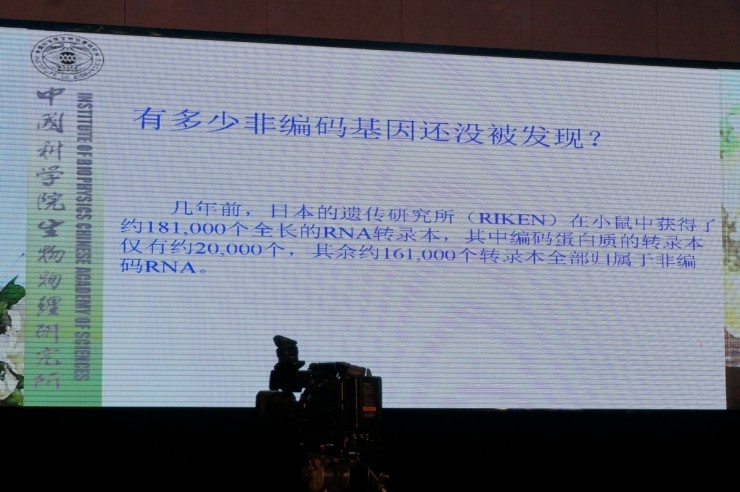
Â
(A large number of non-coding RNAs contain a lot of opportunities)
Â
Therefore, from the perspective of precision medicine, the accuracy we can't really do now is because there is a huge big data, just that his connotation has not been tapped, but on the other hand, he can give us a brand new opportunity. Regardless of the great research on technology research or industrial development, the research on non-coding will undoubtedly provide a new diagnostic direction for the diagnosis and treatment of diseases, or provide a new platform for the design and development of drugs, new species, new traits. The cultivation provides a new foundation. There are many directions for omics, and precision medicine has only just begun.
Â
Everyone is an expert in big data. I think I can only talk about the topic very quickly. In fact, there are still some core challenges in the analysis of big data. The first amount of data is large. Everyone knows that one of the current sequencers Ordinary one-time operation can reach 1T data. There are thousands of such instruments in the world, including my group has the so-called data of getting a T, so the amount of data is very large. Then everyone has 3 × 10 nine powers. This data tells you that in terms of data quality, his noise is very high, and at the same time a large number of such data sources with missing values. The second sample is very small, we have to solve the tumor problem, but we know the tumor variable, the independent variable may be in the top ten thousand, but our sample is only a hundred orders of magnitude, so why do we want to test, for example, to study the tumor or heart Cerebrovascular disease, his own variable is thousands of orders, our million class, just like the government, measuring one million people is enough. Second, we build appropriate mathematical models, using artificial intelligence and machine learning, etc. This allows us to match. Everyone knows that not only the scholastic data, but also the biological data, we need more than just the scientific and technological community, the business community, we know that there is a fundamental problem in our domestic data sharing. If a data sharing problem is not solved, we It is the work of doing small data in the era of big data, and enterprises that publish small data obviously cannot adapt to the situation of international competition.
Â
I am very rough in the back, sorry, take up everyone's time, thank you!
Â
After the lecture by Academician Chen Runsheng, Lei Feng’s reporter also conducted a brief interview with Academician Chen:
Â
Q: Where is the most important challenge for precision medicine?
Â
A: We have a lot of challenges. The foundation of precision medicine is the big data of omics, including omics and big data. For example, omics, we can easily measure the data, but most of the content of the data we do not know. There are also many problems in the mining of big data. There is no time to start today, including the mining of the biological meaning of the data itself, including data samples, defects in the data set itself, such as missing values, and interactions between the originals. There are still many problems. But on the other hand, this is an opportunity. If we understand the unknown data, we can promote one point and then apply a little bit to promote the development of precision medicine.
Â
Q: How do we compare the conditions for conducting precision medical research with the international community?
Â
A: In recent years, our country's emphasis on precision medicine, including investment in basic research, actually has no fundamental difficulties in terms of technical conditions and research. The difficulty comes from various aspects such as organization in scientific research. And how basic research can raise awareness of innovation from the perspective of ideas. From the publication of papers, we are second only to the United States, but it is important to do their own original research, not to follow.
Â
Q: You mentioned that “requires a million-level sample.†We already know that companies like Deepmind and 23andme are already working with health departments and hospitals to obtain millions of sample data. Do we have similar examples in China?
Â
A: There are some projects in China, such as the plan for precision medical research, which plans to measure 1 million data, and it is also in progress. But I don't think it's important to measure which 1 million data. The important thing is that we have a lot of data and need a mechanism to integrate it, which is more important than constantly testing new data.
Â
Guest introduction
Â
Chen Runsheng, bioinformatician, academician of the Chinese Academy of Sciences. He is currently a researcher and doctoral supervisor at the Institute of Biophysics of the Chinese Academy of Sciences. Member of the International Human Genome Organization (HUGO). Systematic and in-depth research on gene annotation, biological evolution, SNP data analysis, biological networks, non-coding genes, etc., has participated in the assembly and gene identification of the B4 genome sequence of the first complete genome of China. Participated in the study of the Human Genome 1% and Rice Genome Work Sketch. In recent years, he has been mainly engaged in system discovery and functional research of non-coding RNA.
Lishida Garlic Chilli Sauce is suitable for dipping and cooking.It serves as a dipping sauce for spring roll,chicken,prawn,all meats and vegetables dishes.Please do not forget add Lishida garlic chilli sauce when you are stir frying spicy cuisines especially for people who love hot food very much.It is available for bulk wholesale,such as supply for supermarkets and restaurants.
Garlic Chilli Sauce,Chilli And Garlic Sauce,Chinese Spicy Garlice Chilli Sauce
KAIPING CITY LISHIDA FLAVOURING&FOOD CO.,LTD , https://www.lishidafood.com